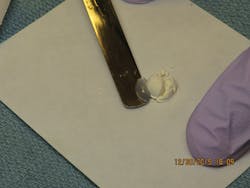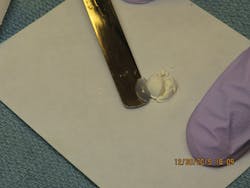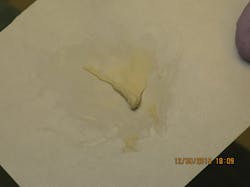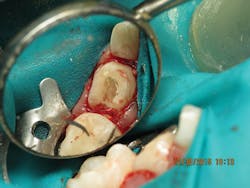Is MTA finally affordable for pediatric pulp therapy?
Zheng Xu, DDS, MDS, PhD
Formocresol is still the most used medicament for pulpotomy in primary teeth despite potential safety concerns over its primary ingredient, formaldehyde. One alternative material, mineral trioxide aggregate (MTA), has demonstrated a high success rate as a primary molar pulpotomy agent in many clinical studies and entails no known health risks.
Surveys have shown that the majority of pediatric dentists preferred MTA as a pulpotomy agent over formocresol, particularly when asked "if cost were not an issue."1 Unfortunately, MTA's significant price premium has made its widespread usage financially unviable.
Recently, however, more cost-effective MTA-type products have become available in the market. This article will examine the merits of MTAs relative to formocresol as a primary teeth pulpotomy agent, and provide observations regarding one of the new MTA products specifically formulated for pediatric dentistry, NuSmile NeoMTA.
ADDITIONAL READING |Vital pulp therapy for primary teeth
Traditional materials for pulp therapy
Formocresol's long history of clinical success has made it the gold standard for primary teeth pulpotomy for almost a century. However, this gold standard's shine has been increasingly tarnished due to reported concerns about its safety over the last 30 years. In 2003, 54% of pediatric dentists in the United Kingdom indicated that they were concerned about the toxic, mutagenic, carcinogenic, or sensitizing effects of formocresol.2 Moreover, several countries have banned the use of formocresol with pediatric patients. One of the main components of formocresol, formaldehyde, is at the center of this controversy.3 Formaldehyde is a known carcinogen when exposed to a large dose directly for long term. The amount of formocresol delivered to the pulp during a pulpotomy is minimal, and it is highly unlikely that formocresol, judiciously used, is genotoxic or poses a cancer risk to children who undergo one or more formocresol pulpotomies.4 However, the concerns over formocresol safety are not unfounded. Additional disadvantages of formocresol pulpotomy include the possibility of early exfoliation of primary teeth, an odor that many patients and clinicians find objectionable, and its potential to burn soft tissue in the event of inadvertent contact with the medicament.
Ferric sulfate, a hemostatic agent, has gained some popularity as a primary teeth pulpotomy agent. It is easy to use and requires a much shorter treatment time. Several review articles support its usage, as it has shown to have similar clinical and radiographic success to formocresol.5 However, widespread adoption of ferric sulfate has been hampered by its likelihood of causing internal root resorption.6,7
ADDITIONAL READING | 'Endo/resto' efficiency: Maximizing time and boosting the bottom line
The advantages of MTA
Mineral trioxide aggregate, or MTA, is a bioactive, noncytotoxic medicament that contains no resins. Originally introduced as a root repair medicament, it has been shown to be used successfully in many endodontic procedures, including pulpotomies, direct pulp-capping, and apexogenesis/apexification.
Given the safety concerns surrounding formocresol, MTA has been studied extensively as an alternative pulpotomy agent for primary teeth. Numerous clinical studies have shown that MTA pulpotomy has a high rate of success, both clinically and radiographically. One of the most recent systematic reviews comparing MTA and formocresol pulpotomies in primary molars concludes, "On the basis of the limited evidence, pulpotomy procedures performed in primary molars involving the use of MTA or formocresol showed comparable clinical success."8 Another study found MTA superior to formocresol, concluding, "The greater success rate of MTA can be attributed to its biocompatibility and sealing ability when compared to formocresol."9
In addition, when compared with ferric sulfate, MTA also demonstrated better long-term treatment outcomes in primary molar pulpotomy.10,11 Overall, as a pulpotomy agent in primary molars, MTA has certainly been proven to perform equally or superior to formocresol or ferric sulfate.
Potential issues with some MTAs
While it enjoys great clinical success, MTA can have its challenges and drawbacks. First, one of the major downsides of MTA is the potential discoloration of the teeth, which can start soon after treatment. This can even be a problem with many white MTAs. As any dentist who treats pediatric patients is well aware, esthetics are increasingly important to parents, most of whom are simply not going to tolerate dark stains on their children's teeth.
Second, MTAs can be difficult to handle and require chairside mixing, which can be particularly problematic when dealing with an anxious and moving pediatric patient. Other challenges of MTA include long setting time, difficulty of removal once set, and high material cost.
A promising new alternative
Recently, I have been evaluating NuSmile NeoMTA, which was developed for pediatric dentists and has been newly introduced to the marketplace. It offers several advantages over some other MTAs I have used in the past. Perhaps the biggest news about this product is its low cost of just over $4.00 per dose. Additionally, clinicians and parents will appreciate the fact that NuSmile NeoMTA is non staining, wash-out resistant, and fast setting. I have also noticed that one particularly clever advantage is its bottle, which protects the powder from moisture, provides effective reseal after opening, and allows the clinician to dispense only what is needed. This plays a big role in the medicament's exceptionally low cost per dose.
This new medicament is easier to work with than other MTAs I have used. First of all, it is easier to mix; its off-white powder is finer, which makes mixing go much more easily and smoothly. It is recommended to use a glass slab in conjunction with a flexible metal spatula, which allows fast incorporation of the powder and gel. Using the gel provided in the kit allows for a smooth and puttylike consistency that is easy to handle, as it prevents dry-out by retaining moisture longer. It sets more quickly than other MTAs; this minimizes chair time, which is always a good thing when you are dealing with pediatric patients with short attention spans. While it can take one to five hours for the material to completely set, depending on your powder to gel ratio, your procedure can be completed as soon as the material has been secured in the pulp chamber using a flowable composite or glass ionomer indicated for pulp capping.
For decades, dentists performing pulpotomy on primary molars have been understandably concerned about potential safety issues with formocresol. While bioactive MTA pulpotomy has a high success rate and no safety issues, its dramatic price premium rendered this impractical for most pediatric dentists. Now, however, new MTA products appear to be cost competitive while delivering excellent bioactivity, handling, and nonstaining benefits.
Mixing NuSmile NeoMTA's gel and powder
Putty created by mixing gel and powder
MTA pulpotomy using NuSmile NeoMTA
References
1. Seale NS, Glickman GN. Contemporary perspectives on vital pulp therapy: Views from the endodontists and pediatric dentists. Pediatric Dentistry 2008;30(3):261–267.
2. Hunter ML, Hunter B. Vital pulpotomy in the primary dentition: Attitudes and practices of specialists in paediatric dentistry practicing in the United Kingdom. International Journal of Paediatric Dentistry 2003;13(4):246–250.
3. Casas, MJ, Kenny DJ, Judd, PL, Johnston DH. Do we still need formocresol in pediatric dentistry? Journal of the Canadian Dental Association 2005;71(10):749–751.
4. Milnes AR. Is formocresol obsolete? A fresh look at the evidence concerning safety issues. Pediatric Dentistry 2008;30(3):237–246.
5. Peng L, Ye L, Guo X, Tan H, Zhou X, Wang C, Li R. Evaluation of formocresol versus ferric sulphate primary molar pulpotomy: A systematic review and meta-analysis. International Endodontic Journal 2007;40(10):751–757. Epub 2007.
6. Sonmez D, Sari S, Cetinbas T. A comparison of four pulpotomy techniques in primary molars: A long-term follow-up. Journal of Endodontics. 2008;34:950–955.
7. Salako N, Joseph B, Ritwik P, Salonen J, John P, Junaid TA. Comparison of bioactive glass, mineral trioxide aggregate, ferric sulfate, and formocresol as pulpotomy agents in rat molar. Dental Traumatology 2003;19:314–320.
8. Marghalani AA, Omar S, Chen JW. Clinical and radiographic success of mineral trioxide aggregate compared with formocresol as a pulpotomy treatment in primary molars: A systematic review and meta-analysis. Journal of the American Dental Association 2014 Jul;145(7):714–721. doi: 14219/jada.2014.36.
9. Olatosi OO, Sote EO, Orenuga OO. Effect of mineral trioxide aggregate and formocresol pulpotomy on vital primary teeth: A clinical and radiographic study. Nigerian Journal of Clinical Practice. 2015;18(2):292–296.
10. Asgary S, Shirvani A. Fazlyab M. MTA and ferric sulfate in pulpotomy outcomes of primary molars: A systematic review and meta-analysis. The Journal of Clinical Pediatric Dentistry. 2014;39(1).
Zheng Xu, DDS, MDS, PhD, is a clinical associate professor in pediatric dentistry at the University of Washington. Dr. Xu is also a consultant for the American Board of Pediatric Dentistry and a member of the editorial board of Pediatric Dentistry, the official journal of the American Academy of Pediatric Dentistry.



